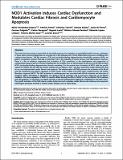Por favor, use este identificador para citar o enlazar a este item:
http://hdl.handle.net/10261/57730COMPARTIR / EXPORTAR:
 SHARE SHARE
 CORE
BASE CORE
BASE
|
|
| Visualizar otros formatos: MARC | Dublin Core | RDF | ORE | MODS | METS | DIDL | DATACITE | |

| Título: | NOD1 activation induces cardiac dysfunction and modulates cardiac fibrosis and cardiomyocyte apoptosis |
Autor: | Fernández-Velasco, María CSIC ORCID; Prieto, Patricia CSIC ORCID; Terrón, Verónica CSIC; Delgado, Carmen CSIC ORCID ; López-Collazo, Eduardo CSIC; Martín-Sanz, Paloma CSIC ORCID ; Boscá, Lisardo CSIC ORCID CVN | Palabras clave: | Immune system Toll like receptors TLR Pathogenesis NOD1 Down-regulation |
Fecha de publicación: | 18-sep-2012 | Editor: | Public Library of Science | Citación: | PLoS ONE 7(9): e45260 (2012) | Resumen: | The innate immune system is responsible for the initial response of an organism to potentially harmful stressors, pathogens or tissue injury, and accordingly plays an essential role in the pathogenesis of many inflammatory processes, including some cardiovascular diseases. Toll like receptors (TLR) and nucleotide-binding oligomerization domain-like receptors (NLRs) are pattern recognition receptors that play an important role in the induction of innate immune and inflammatory responses. There is a line of evidence supporting that activation of TLRs contributes to the development and progression of cardiovascular diseases but less is known regarding the role of NLRs. Here we demonstrate the presence of the NLR member NOD1 (nucleotide-binding oligomerization domain containing 1) in the murine heart. Activation of NOD1 with the specific agonist C12-iEDAP, but not with the inactive analogue iE-Lys, induces a time- and dose-dependent cardiac dysfunction that occurs concomitantly with cardiac fibrosis and apoptosis. The administration of iEDAP promotes the activation of the NF-κB and TGF-β pathways and induces apoptosis in whole hearts. At the cellular level, both native cardiomyocytes and cardiac fibroblasts expressed NOD1. The NLR activation in cardiomyocytes was associated with NF-κB activation and induction of apoptosis. NOD1 stimulation in fibroblasts was linked to NF-κB activation and to increased expression of pro-fibrotic mediators. The down-regulation of NOD1 by specific siRNAs blunted the effect of iEDAP on the pro-fibrotic TGF-β pathway and cell apoptosis. In conclusion, our report uncovers a new pro-inflammatory target that is expressed in the heart, NOD1. The specific activation of this NLR induces cardiac dysfunction and modulates cardiac fibrosis and cardiomyocyte apoptosis, pathological processes involved in several cardiac diseases such as heart failure. | Descripción: | This is an open-access article distributed under the terms of the Creative Commons Attribution License.-- et al. | Versión del editor: | http://dx.doi.org/10.1371/journal.pone.0045260 | URI: | http://hdl.handle.net/10261/57730 | DOI: | 10.1371/journal.pone.0045260 | ISSN: | 1932-6203 |
| Aparece en las colecciones: | (IIBM) Artículos (CIB) Artículos |
Ficheros en este ítem:
| Fichero | Descripción | Tamaño | Formato | |
|---|---|---|---|---|
| NOD1 Activation.pdf | 1,52 MB | Adobe PDF |  Visualizar/Abrir |
CORE Recommender
PubMed Central
Citations
17
checked on 25-mar-2024
SCOPUSTM
Citations
38
checked on 23-abr-2024
WEB OF SCIENCETM
Citations
37
checked on 25-feb-2024
Page view(s)
377
checked on 24-abr-2024
Download(s)
418
checked on 24-abr-2024
Google ScholarTM
Check
Altmetric
Altmetric
Artículos relacionados:
NOTA: Los ítems de Digital.CSIC están protegidos por copyright, con todos los derechos reservados, a menos que se indique lo contrario.
